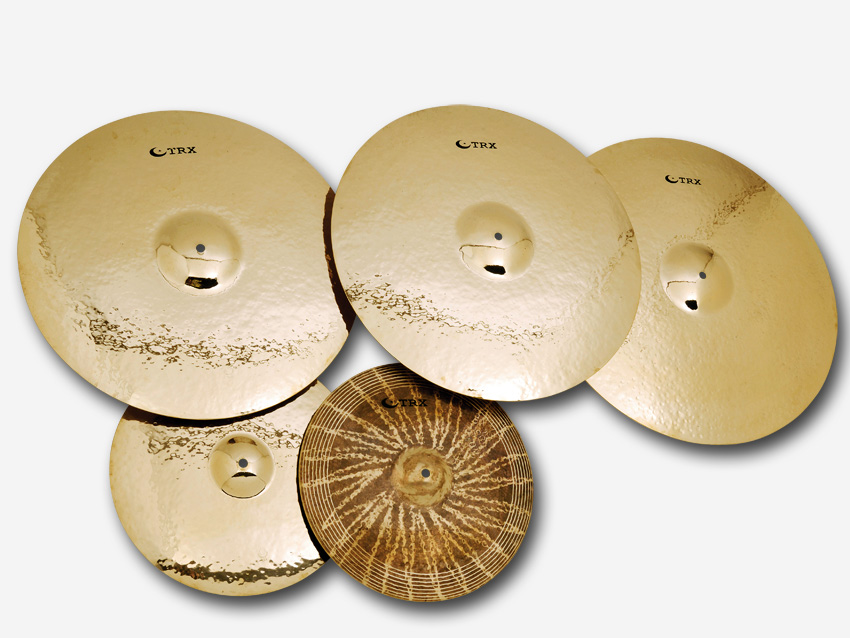MusicRadar Verdict
The addition of larger sizes means that TRX now has a wide selection of cymbals in the BRT range to fulfil almost any requirement. The crashes would work as excellent crash/ rides for today's modern guitar music, and the ride would sit perfectly in a metal setting.
Pros
- +
Perfectly usable cymbals with warm, deep sounds. New improved, smaller logo.
Cons
- -
Their hand-hammered nature won't suit every setting. The crashes are too thin for some.
MusicRadar's got your back
What do Spider-Man and TRX's new oversized BRT series cymbal additions have in common? David Levine, spokesman for the California-based company, suggests that the cymbals offer "great power". But of course, according to the comic book's famous credo: "With great power comes great responsibility."
With a new, sizeable 24" BRT ride, 20" and 21" crashes, and 15" hi-hats all joining the BRT catalogue, is Levine's statement accurate? Are the BRTs powerful like Venom, or are they as hopeless as Spidey's geeky alter-ego Peter Parker?
Our Spidey-senses are starting to tingle...
Build
TRX is dedicated to producing handcrafted Turkish cymbals with a contemporary edge for today's progressive drummers.
"Far from being clanging bin-lids, the crashes exhibit a pronounced edge-wobble that's characteristic of thinner, hand-hammered cymbals"
BRT is, as the abbreviated nomenclature suggests, TRX's take on bright, cutting cymbals. Described as 'extra heavy', the BRT range is extensively hand-hammered, but unlathed, and then polished to a brilliant finish.
The BRT range encompasses a wide selection of sizes, from 10" hi-hats to the new, oversized cymbals. The ride is a whopping 24" and features a shallow profile and flattish bell, the buffed finish bearing the minimal TRX logo and model designation. The 20" and 21" crashes have a flatter bell still, but could easily pass for a ride if singled out, even though TRX insists they were developed specifically as crashes.
Want all the hottest music and gear news, reviews, deals, features and more, direct to your inbox? Sign up here.
"We recently began noticing that more and more drummers were playing the bigger sizes, and some were even using 21" and 22" ride cymbals as crashes," says Levine, "but ride cymbals aren't designed to be crash cymbals. It's not the right sound."
The 15" hats are a mismatch of BRT top and DRK bottom - the latter being TRX's unlathed pre-aged finish, although straight BRT pairs are available as well. With the exception of the DRK bottom, the hats and crashes resemble the ride, polished to a gleaming shine with prominent hammer marks.
Hands on
TRX describes the BRT range as 'extra heavy', and while that may be true of the ride, the crashes are surprisingly versatile. Far from being clanging bin-lids, the crashes exhibit a pronounced edge-wobble that's characteristic of thinner, hand-hammered cymbals and allow you to really dig in to the edge without fear of it being too brittle.
The wobble means the crashes start quietly but quickly build up to a fearsome roar - perfect for use as a crash/ride. The 20" is marginally quicker to speak, as you would expect, but these things are relative - with such large diameters, the crashes take a moment to return to equilibrium before opening up again. Both are tonally darker than you'd expect for such rock-orientated cymbals, which points to their hand-hammered Turkish origins.
The ride, though, is significantly thicker, and delivers a strident clear tone from even the lightest tap. It feels much more solid under the stick, with little evidence of the edge wobble of the crashes, although again, once you get it moving, the volume quickly builds.
The bell isn't as prominent as some of its Stateside or Swiss contemporaries, but it cuts cleanly through for that power-ballad, chorus feel.
The hats were something of a revelation. Despite their size they performed faultlessly in a soul-band setting - the thinner DRK bottom tempering the heavier BRT top. Far from only being suited to heavier musical styles, the pairing could be used in most settings, from big band to metal.
